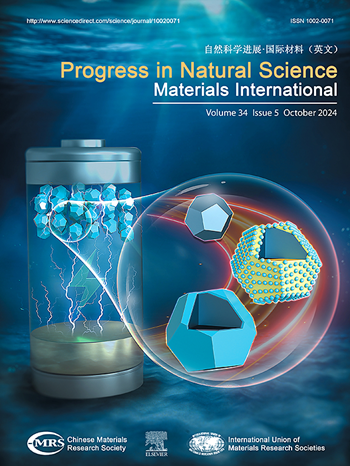提出了一种提高铝锂合金蠕变时效成形性能和保持合金性能的多级蠕变时效新工艺
IF 7.1
2区 材料科学
Q2 MATERIALS SCIENCE, MULTIDISCIPLINARY
Progress in Natural Science: Materials International
Pub Date : 2025-06-01
DOI:10.1016/j.pnsc.2025.03.004
引用次数: 0
摘要
针对铝锂合金蠕变时效成形性弱的特点,传统的单阶段蠕变时效工艺无法保证成形性与性能之间的平衡。本文提出了一种新型的多阶段蠕变时效工艺(MSCA),该工艺首先在低温下获得较好的组织,然后提高温度以获得较好的成形性,最后通过低温下的二次析出强化来补偿高温造成的强度损失,从而实现成形性与性能的良好匹配。MSCA能在不降低强度和塑性的情况下有效地增加蠕变应变。通过各种微观表征方法观察材料的内部微观结构,发现MSCA第一阶段需要获得大量的弥漫性析出相,这样才能在MSCA第二阶段(高温)获得较大蠕变应变的同时抑制粗化;第二阶段温度的选择应考虑位错恢复程度和析出相再溶解程度,使MSCA的第三阶段强度可以通过二次析出强化得到提高;应降低第三阶段温度,以避免析出相变粗,并确保MSCA在较高蠕变应变下仍可与单阶段蠕变时效相媲美。这项工作对改进和发展蠕变时效具有重要意义。本文章由计算机程序翻译,如有差异,请以英文原文为准。

A new multi-stage creep aging process for improving creep age formability and maintaining performance of Al-Li alloy
In response to the weak creep age formability of Al-Li alloy, the traditional single-stage creep ageing process cannot guarantee a balance between formability and performance. This work proposes a novel multi-stage creep aging process (MSCA), which obtains a better microstructure firstly at low temperature, then increases the temperature to obtain better formability, and finally compensates for the loss of strength caused by high temperature through the secondary precipitation strengthening at low temperature, achieving a good match between formability and performance. The MSCA can effectively increase creep strain without reducing strength and plasticity. By observing the internal microstructure of the material through various microscopic characterization methods, it was found that the first stage of MSCA needs to obtain a large amount of diffuse precipitates, so that it can suppress coarsening while obtaining a large creep strain in the second stage (high temperature) of MSCA; The selection of the second stage temperature should take into account the degree of dislocation recovery and precipitate re-solution, so that the strength of the third stage of MSCA can be improved by secondary precipitation strengthening; The third stage temperature should be lowered to avoid coarsening of precipitates and to ensure that the MSCA is still comparable to single-stage creep aging with a higher creep strain. This work has important implications for the refinement and development of creep aging.
求助全文
通过发布文献求助,成功后即可免费获取论文全文。
去求助
来源期刊
CiteScore
8.60
自引率
2.10%
发文量
2812
审稿时长
49 days
期刊介绍:
Progress in Natural Science: Materials International provides scientists and engineers throughout the world with a central vehicle for the exchange and dissemination of basic theoretical studies and applied research of advanced materials. The emphasis is placed on original research, both analytical and experimental, which is of permanent interest to engineers and scientists, covering all aspects of new materials and technologies, such as, energy and environmental materials; advanced structural materials; advanced transportation materials, functional and electronic materials; nano-scale and amorphous materials; health and biological materials; materials modeling and simulation; materials characterization; and so on. The latest research achievements and innovative papers in basic theoretical studies and applied research of material science will be carefully selected and promptly reported. Thus, the aim of this Journal is to serve the global materials science and technology community with the latest research findings.
As a service to readers, an international bibliography of recent publications in advanced materials is published bimonthly.

 求助内容:
求助内容: 应助结果提醒方式:
应助结果提醒方式:


